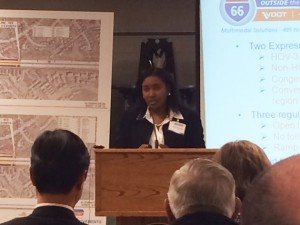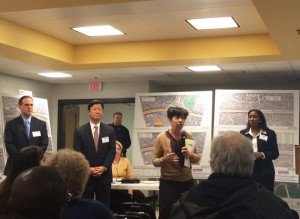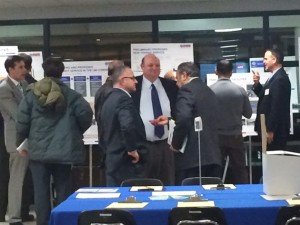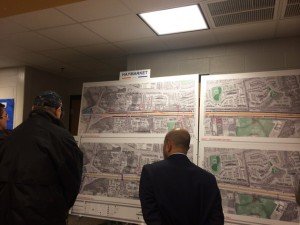 Residents who attended the meeting ask questions during a Q&A session.[/caption]
Residents who attended the meeting ask questions during a Q&A session.[/caption] Many local motorists feel conflicted about the new changes coming to I-66 after Virginia Department of Transportation (VDOT) representatives announced they would be adding additional express lanes to the highway, but no new regular lanes.
Many showed up to view VDOT's plans and listen to a presentation held at Battlefield High School in Haymarket Wednesday evening. It was one of four public information meetings VDOT had scheduled this week on I-66 improvements outside the Capital Beltway, though they canceled the first two due to weather.
Haymarket commuters were very interested in learning about road improvements, as many of them travel long distances to work via I-66 - some the entire 25 miles to the Beltway, others to points in between. The residents listened respectively and seemed genuinely excited about the improvements VDOT was proposing. However, they also brought up some real concerns.
Express Lanes
 Deputy District Administrator Rene Hamilton begins the meeting presenting the facts about the two road proposals.
Deputy District Administrator Rene Hamilton begins the meeting presenting the facts about the two road proposals.Deputy District Administrator Rene Hamilton, who led the presentation, emphasized many exciting changes VDOT and the Virginia Department of Rail and Public Transportation (DRPT) have planned for the I-66 corridor outside of the Beltway. These changes include new express lanes and multimodal forms of transportation extending to I-15.
However, attendees of the meeting were concerned that VDOT had no plans to add any regular lanes to the highway, and that existing HOV lanes would become more restrictive.
VDOT plans to keep the three regular lanes, and eliminate the one HOV2 lane (high occupancy vehicle with two passengers), replacing it with two HOV3 lanes when the new roads open in 2021.
Vehicles with two or fewer passengers would be able to gain access to the HOV lanes through a tolling system. Once motorists enter the expressway, they would be separated from general traffic, allowing for fewer entrances and egresses.
Hamilton said this system should create more consistent traffic flow and should keep traffic on the express lanes moving at a minimum of 45 miles per hour. It would also stop violators and constant lane changing.
Another benefit of the new system is the various opportunities for express transit via commuter buses and unofficial ride shares, or “slugging.”
Park & Ride
 VDOT representatives answer attendee questions.
VDOT representatives answer attendee questions.VDOT has already begun building new park & ride lots, such as the one along Balls Ford Road in Manassas that opened in the summer of 2013. They plan to add another commuter lot across from Walmart at the intersection of Route 55 and Route 15 in Haymarket and another one along University Boulevard in Gainesville.
At those lots, commuters will be able to board transit buses that ride exclusively on the HOV3 lanes and offer high frequency and predictable travel times. VDOT representatives said those buses would run all day long, so people could return home from work early or use them to visit D.C., Arlington, Tysons Corner or other points east.
Commuters could also use those lots to “slug” or car pool, so that more vehicles could meet HOV lane requirements.
Limitations on Hybrid Vehicles
Those who already own hybrid vehicles with special license plates were told those plates would no longer grant them access to the HOV3 lanes. Like everyone else, they could access HOV3/express lanes by paying a toll, or by taking on more passengers.
Many found this to be disappointing, but a VDOT spokesperson said the hybrid incentives were always planned to “sunset.” Additionally, as people pay extra to maintain those plates, they could opt out at renewal times. The changes to the HOV lanes would not come into effect until the road opens in 2021, not during construction.
Two Proposed Road Alternatives
 Meeting attendees talk with VDOT personnel after the meeting.
Meeting attendees talk with VDOT personnel after the meeting.While VDOT considered various types of road improvements, at this point, they have narrowed down their proposal to two plans, Alternative 2A and 2B.
Alternative 2A would provide space beyond the median for the metro rail or VRE to come out to Gainesville or Haymarket in the future. Alternative 2B would not. By not offering space for metro rail, the second alternative would require less right of way and no median. That alternative is also less expensive.
VDOT anticipates taking small parcels of right of way along the 25-mile route, and some bigger parcels to accommodate the new park & ride lots. Under the two existing plans, they would need to take between 63 and 93 parcels of land, most of which are small slivers, and 6 to 7 parcels of park land. There would be zero to three residential relocations. They are still working to reduce those numbers.
Hamilton explained that VDOT put everything on the table and started out with 47 alternatives that were whittled down over time.
VDOT spokespersons recognized that the new road improvements would not solve all congestion problems on I-66. However, they said it would offer alternatives. If a person needs to get somewhere quickly, he or she could elect to pay to enter the express lanes, take a bus or carpool.
Tolling and Public/Private Partnership
 People who came before the presentation portion of the meeting look at plans.
People who came before the presentation portion of the meeting look at plans.Another concern attendees had with the plan involved the money generated by tolling. VDOT representatives explained that a private-public partnership would help them to fund the road improvements. One man asked if the purpose of the toll roads was meant to benefit private investors or the public, and asked if it would not be more beneficial for drivers to build additional regular lanes.
Megaproject Director Susan Shaw said the purpose of the private-public partnership was to build the improvements quickly and cost-effectively. She said that if they widen the highway any more they will affect many land owners, especially in Fairfax and Arlington.
But the private-public partnership also offers many advantages to the public, explained another VDOT spokesperson. It would save taxpayers somewhere between $700 million and $1 billion dollars in construction costs. It will expedite the project by several years, and it would provide funds in the future to maintain those roads without additional taxes.
Overall the project will cost $2-3 billion dollars, meaning the partnership would offer significant savings.
Investors in the project pay into the project right away and assume many of the financial risks. They will collect on their investment over the long-term, such as the next 40 years, as toll money goes towards road maintenance and investors’ returns.
Other Alternatives Considered
Throughout the construction, regular roads would remain open on I-66 as well as the one HOV2 lane. VDOT expects that traffic will not worsen in the regular traffic lanes.
A VDOT representative said that reversible peak-time express lanes were eliminated as an option because traffic is also relatively high in the opposite direction during peak times and that I-66 has congestion problems even during non-peak hours.
A spokesperson answered an attendee who inquired as to why Prince William could not get a metro extension now. He said that additional riders in the west would also increase demand on the mature metro system in the east.
They noted that I-66 is being modeled on some of the improvements that have worked along I-95.
Wednesday afternoon on WTOP, Governor Terry McAuliffe expressed his excitement over the new options for I-66, which he endorses.
Burying Power Lines
Shaw said that VDOT is talking with Dominion Power about the possibility of the Haymarket power lines running along I-66, so this project does not eliminate that option.
Time Line
VDOT plans to continue to keep the community informed. They are currently gathering data about environmental impact. There will be an environmental public hearing in May. The request should be finalized and granted by the end of 2015.
They expect funding will be finalized by December of 2016. They will start construction in 2017, and it should be open to traffic in 2021. VDOT has called this timeline “aggressive.”
Citizen Responses
Many citizens told VDOT representatives they were happy something was finally being done about the congestion on I-66; they just wished the plan would have included more regular lanes.
Becky Peck drives from Haymarket to the Fairfax County Parkway to work and back every weekday. It takes her about 45 minutes to an hour to travel on I-66 in the mornings.
Peck said she bought a hybrid to make her trip to work faster, but once the new roads open, she will now have to spend money to travel in the express lanes.
“I don’t think this is the whole solution,” she said, concerned that VDOT is relying too heavily on toll roads to reduce traffic congestion.
Knowing that it can cost up to $7 to travel on 95, she estimated it could cost her $70 weekly to commute to and from work if she takes the express lanes.
Support Bristow Beat - Donate Today!